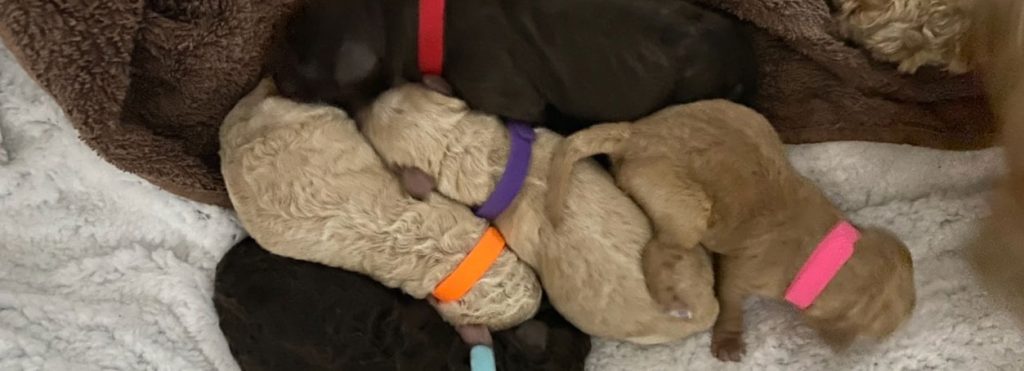
Labradoodles have become a popular choice for families looking for a new canine companion. If you are considering bringing a Labradoodle into your home, it is important to understand the differences between the different types of Labradoodle. In this blog post, we will discuss the four most common types of Labradoodle: F1, F1B, F2, and F2B, and explore how they differ from one another.
F1 Labradoodle – The Original
An F1 Labradoodle is the first generation of a cross between a Labrador Retriever and a Poodle. The resulting puppies have a unique combination of traits from both parents, giving them a range of physical characteristics, coats, colors, and personalities. As the first generation, F1 Labradoodles are considered to be the “original” type of Labradoodle.
F1 Labradoodles can vary greatly in size, coat texture, and color, depending on the genetics of their parents. They usually have a medium-length coat that can be curly or wavy and come in a variety of colors, from black and white to cream, gold, and red. Generally, F1 Labradoodles are not considered to be the most low-shedding and hypoallergenic of the different generations of Labradoodle.
F1B Labradoodle – First Generation Backcross
An F1B Labradoodle is a cross between an F1 Labradoodle (first generation Labradoodle) and a Poodle. This type of Labradoodle is becoming increasingly popular due to its hypoallergenic coat and potential for non-shedding. The F1B Labradoodle will typically have 75% poodle and 25% Labrador Retriever, making them more predictable in terms of their coat type, temperament and size.
Generally, they will have a softer, curlier coat than an F1 Labradoodle, and are more suitable for allergy sufferers as they shed very little, if at all. However, like any other dog, they should still be groomed regularly to keep their coat looking its best.
F2 Labradoodle – Second Generation
An F2 Labradoodle is a second generation cross between a Poodle and a Labrador Retriever. It is the result of breeding an F1 Labradoodle with another F1 Labradoodle. The F2 generation is considered to be a 50/50 mix of the two breeds, with approximately half the genetic makeup from each parent.
The appearance of an F2 Labradoodle will depend on the dominant traits passed down from its parents, but it can range from a scruffy coat to a shaggy coat to a wavy coat. Depending on which traits are more dominant, an F2 Labradoodle can also have a low to moderate shedding coat.
F2 Labradoodles are often considered to be less predictable than their F1 and F1B counterparts, as they are less likely to produce offspring that resemble either parent breed. They can range in size and weight, and even temperament, depending on the individual parent breeds used in the breeding process.
Despite their unpredictability, F2 Labradoodles can still make great pets. They often have a high level of intelligence and trainability, and many owners report that they have an excellent temperament. However, it is important to remember that all Labradoodles are individuals, and even within the same generation there can be quite a bit of variation.
F2B Labradoodle – Second Generation Backcross
An F2B Labradoodle is a type of Labradoodle that is the result of breeding an F1 Labradoodle with an F1B Labradoodle. This type of Labradoodle is known as a “second generation backcross” because it is the result of crossing two first-generation Labradoodles. The purpose of breeding an F2B Labradoodle is to create a Labradoodle with more consistent traits and less shedding than the original F1 Labradoodle. F2B Labradoodles are typically about 65% Poodle, 35% Labrador Retriever.
F2B Labradoodles tend to have a more hypoallergenic coat and be less prone to shedding than the F1, F1B, & F2 Labradoodles. They can also be smarter and more obedient than the original F1 Labradoodle. Although they still require plenty of exercise and mental stimulation, they tend to be calmer than the F1 Labradoodle and easier to train.
An F2B Labradoodle’s lifespan can range from 12-15 years depending on their diet, activity levels, and genetics. It is important for potential owners to do their research before bringing an F2B Labradoodle home in order to provide them with everything they need for a healthy and happy life.
Grooming needs vary from dog to dog, but most F2B Labradoodles require regular brushing and occasional grooming. Since they shed minimally, they make great companions for people with allergies.
All in all, an F2B Labradoodle is a great option for those looking for an intelligent, friendly, and low maintenance pet and are well known for being the breed of choice for Labradoodles!